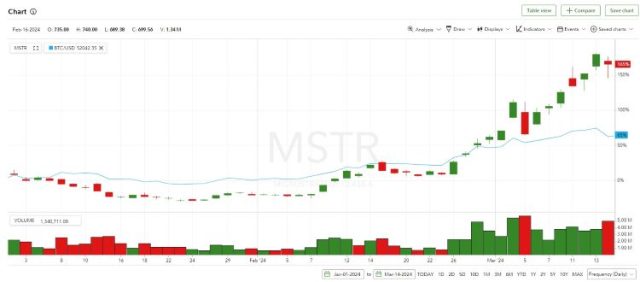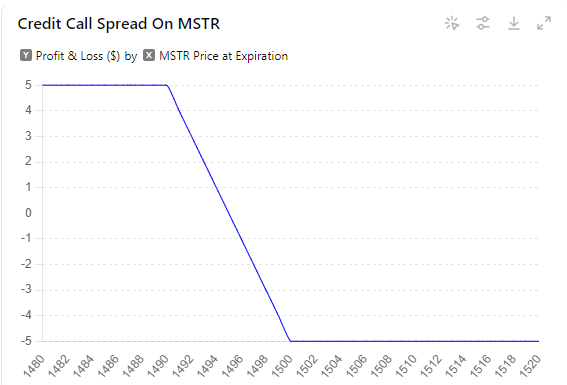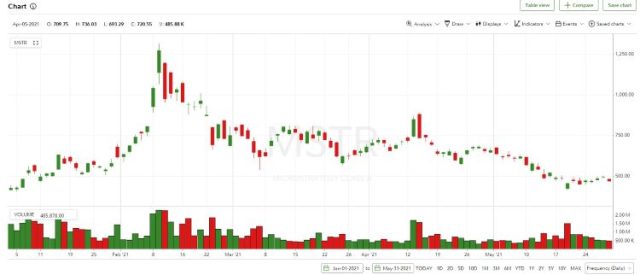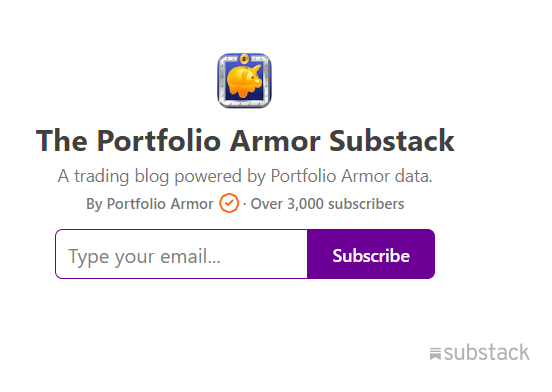
The Last Time MicroStrategy Went Parabolic
Remember back in mid-March, when Bitcoin was up about 65% year-to-date but MicroStrategy (MSTR), the firm best known for hoarding Bitcoin on its balance sheet, was up 165% YTD?

If you do remember that, you probably thought that was crazy. We did too.
You probably also thought about betting against it. You probably didn’t though, right? You didn’t want to short shares of MSTR, for good reason: what if the stock kept going up? Your potential losses would have been unlimited, and you could have started getting margin calls from your broker.
Maybe you thought about buying puts on MicroStrategy instead, but balked at the ridiculous prices for them. We certainly did. Instead, we used another approach: taking advantage of ridiculous options prices on MicroStrategy at the time to profit from selling options. Here’s how we did it.
Our Trade Thesis
Our thesis was pretty simple: Bitcoin prices had probably gotten ahead of themselves, but even if they hadn’t MicroStrategy’s share price certainly had.
Structuring The Trade
When option prices are high, we look for ways to sell them. Just as buying a put option on a stock is a way to bet against stock, so too is selling a call option on it. The problem with selling a naked call (i.e., when you don’t own the underlying stock) is that your risk is unlimited. However high that stock price goes, you will be obligated by the call option contract you sell to deliver it to the party that bought the contract from you. That means, you’ll have to buy the stock at the current market price, whatever that is.
Instead, we opened a credit call spread on MicroStrategy. A credit call spread is when you sell call option on a security, but buy the next higher strike call option. We decided to use in-the-money calls to generate a higher credit. We wanted a net credit high enough so that our max gain was equal to our max loss, so we put in a limit order for a net credit of $5:
Components of the Credit Call Spread:
- Sell $1,490 Call: Expiring 6/21/2024
- Buy $1,500 Call: Expiring 6/21/2024
- Net Credit Received: $5
Key Points:
- Max Gain: The maximum gain occurs if MSTR is at or below $1,490 at expiration.
- Max Loss: The maximum loss occurs if MSTR is at or above $1,500 at expiration.
- Break-Even Point: The break-even point is the strike price of the short call plus the net credit received.
Calculations:
- Max Gain: The net credit received, which is $5.
- Max Loss: The difference between the strike prices ($1,500 – $1,490 = $10) minus the net credit received ($10 – $5 = $5).
- Break-Even Point: $1,490 (strike price of the short call) + $5 (net credit received) = $1,495.
Basically, if MicroStrategy closed above $1,500 per share on Friday, we would have lost $500 per contract; if it closed below $1,490, we would have kept $500 per contract; and if closed at some price between $1,490 and $1,500, we would have lost less than $500 if it closed below $1,495 and we would have made less than $500 if it closed above $1,495.

As it happened, MicroStrategy closed at $1,483.76 on Friday, so we made a 100% profit on our trade.
Why The June Expiration?
We looked the last time, MicroStrategy had gone parabolic, back in 2021, and saw that it gave back most of its gains within three months.

Its drop this year has been much more modest, but it did fall enough within a few months for our trade to cash.
This Approach Works Best For Volatile Names
Different situations call for different approaches. In our most recent bearish trade, a bet against a regional bank, we wouldn’t have gotten attractive prices for a credit call spread on it. In that case, we simply bought puts on it.
Click on the old timey bank image to go to that post.
If you’d like a heads up when we place our next trade, feel free to subscribe to our trading Substack/occasional email list below.
If you’d like to stay in touch
You can scan for optimal hedges for individual securities, find our current top ten names, and create hedged portfolios on our website. You can also follow Portfolio Armor on X here, or become a free subscriber to our trading Substack using the link below (we’re using that for our occasional emails now).



